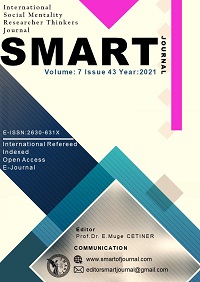Author :
Abstract
ÖZET Ekonomik entegrasyonun dünya çapında ivme kazanmasıyla birlikte iktisadi şokların sıklığı artmaya ve etki alanları genişlemeye başlamıştır. Bu şokların ekonomi üzerindeki zararlı etkilerinin yok edilme- si noktasında döviz kuru önemli bir politika aracı olarak kabul edilmektedir. Bu çalışmanın amacı, seçil- miş gelişmekte olan açık ekonomiler olarak tanımlanan Türkiye, Brezilya ve Meksika için döviz kuru- nun şok emici işlevinin varlığının araştırılmasıdır. Bu amaçla uzun dönem ve kısa dönem kısıtlarının bir kombinasyonunu barındıran yapısal VAR metodolojisi takip edilmiştir. Döviz kuru sadece şoklar asimetrik karaktere sahipse şok emici özellik göstermektedir. Analiz sonuçları uyarınca, Türkiye ve Brezilya için kriz öncesi ve kriz sonrası periyotlarda şokların asimetrik olduğu sonucuna ulaşılmıştır. Meksika’da sa- dece kriz sonrası arz şokları asimetrik özellik göstermektedir. Söz konusu dönemlerde bu ülkeler için dö- viz kurunun şok emici işlevi etkindir. Ayrıca döviz kurunun kendi şoklarını yaratmadığı tespit edilmiştir.
Keywords
Abstract
HIGH ABSORBENT FUNCTION OF EXCHANGE DRY ABSTRACT The frequency and sphere of influence of the economic shocks began to extend with the acceleration of the global economic integration. The exchange rate is regarded as an important policy instrument in terms of the destroying of the harmful effects of these shocks on economy. The aim of this study is to investigate the shock absorber role of the exchange rate in selected open developing economies: Turkey, Brazil, Mexico, In this context, the structural VAR framework with long run and short run restrictions is employed. The exchan- ge rate can behave as an shock absorber only if shocks have asymmetric property. Our study finds that, real shocks in Turkey and Brazil relative to the trading partner have been asymmetric during the both the pre-and post-crisis periods. In Mexico, the exchange rate is a potential shock absorber for only supply shocks in post-crisis period. In this framework, it is found that exchange rate has an efficient shock absorbing role for mentioned countries. Also, it does not breed its own shocks.
Keywords
- Artis, M., Ehrmann, M. (2006). “The exchange rate - A shock-absorber or source of shocks? A study of
- Artis, M., Ehrmann, M. (2006). “The exchange rate - A shock-absorber or source of shocks? A study of four open economies”. Journal of International Money and Finance, s. 25(6), 874-893.
- Bayoumi, T., Eichengreen B. (1992a). “Macroeconomic Adjustment Under Bretton Woods and thePost- Bretton-Woods Float: An Impulse-Response Analysis”. CEPR Discussion Papers.729 C.E.P.R. Discussion Papers.
- Bayoumi, T., Eichengreen B. (1992b). “Is There a Conflict Between EC Enlargement and European Mone- tary Unification?” CEPR Discussion Papers 646, C.E.P.R. Discussion Papers.
- Bayoumi, T., Thomas, A. (1995). “Relative Prices and Economic Adjustment in theUnited States andthe European Union: A Real Story About European Monetary Union”. Staff Papers, International Monetary Fund, s. 42,108–133.
- Blanchard, O., Quah, D.. (1989). “The Dynamic Effects of Aggregate Demand and Supply Disturbances.” The American Economic Review, s. 79. 655-673.
- Bogdanski, J., Tombini, A.A.,Werlang, S.R.C. (2000), “Implementing Inflation Targeting in Brazil.” Cent- ral Bank of Brazil Working Paper 1.
- Clarida, R., Gali, J., (1994). “Sources of Real Exchange Rate Fluctuations: How Important are Nominal Shocks?,” CEPR Discussion Papers 951, C.E.P.R. Discussion Papers.
- Funke, M., (2000). “Macroeconomic shocks in Euroland vs the UK: supply, demand, or nominal?” Quanti- tative Macroeconomics Working Papers, 20001, Mimeo, University of Hamburg.
- Galindo, L.M., Ros, J., (2005) “Inflation Targeting Mexico: An Empirical Appraisal” Amherst/CEDES Conference on Inflation Targeting. Buenos Aires, 2005.30.
- Goo, S., Siregar R., (2009). “Economic Shocks and Exchange Rate as a Shock Absorber in Indonesia and Thailand”. MPRA Paper 16875, University Library of Munich, Germany.
- Hansen, L.P., (1982), “Large Sample Properties of Generalized Methods of Moments Estimators” Econo- metrica, s. 50, 1029-1054.
- Lastrapes, William. D. (1992). “Sources of fluctuations in real and nominal exchange rates”. Review of Economics and Statistics. s. 74(3), 530-539.
- Shapiro, M., Watson, M., (1988). “Sources of Business Cycles Fluctuations, “NBER Chapters, in: NBER Macroeconomics Annual 1988, s 3, 111-156.
- Siok, K. S., (2010), “The Source of Shocks and the Role of Exchange Rate as a Shock Absorber: ACom- parative Study in the Crisis-hit East-Asian Countries.”.Journal of Mathematics Research, s. 2- 1,123-138.
- Smets, F., (1997). “Measuring monetary policy shocks in France, Germany and Italy: the role of the exc- hange rate.” Swiss Journal of Economics and Statistics 133, 597-616.
- Thomas, A., (1997). “Is the exchange rate a shock absorber? The case of Sweden.” IMF Working Paper 97/176.
- Türkiye Cumhuriyeti Dış Ticaret Müsteşarlığı, [02.12.2011], www.dtm.gov.tr/dtmadmin/upload/ead/disti- caretdegerelendirmedb/iii-6.doc.
